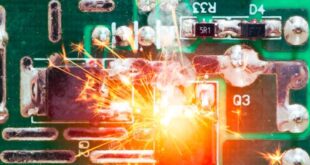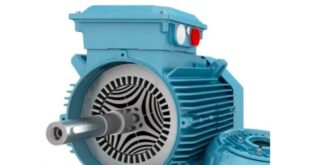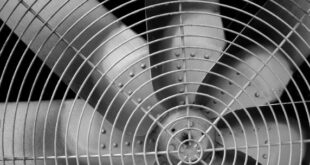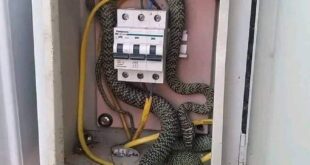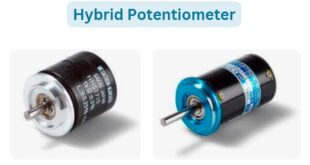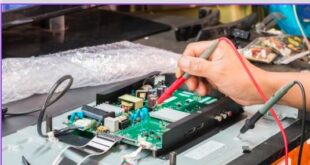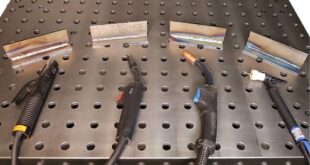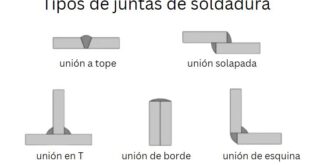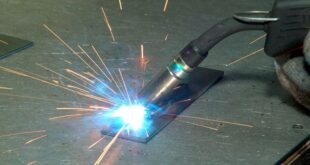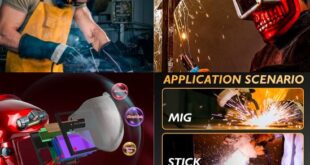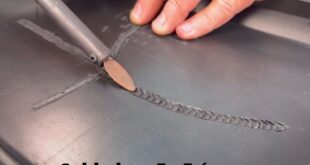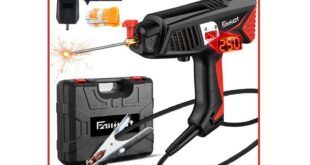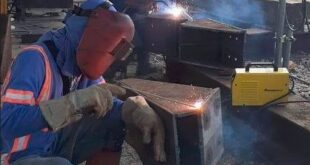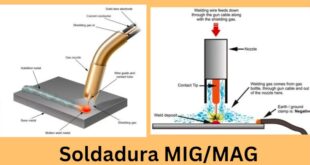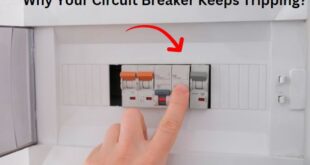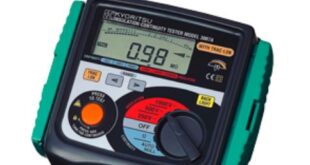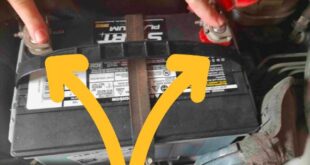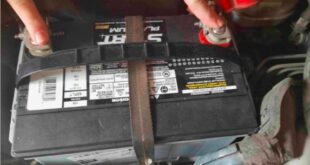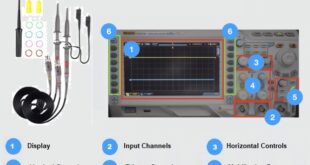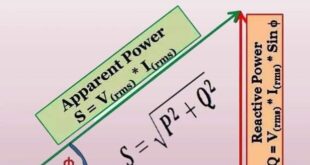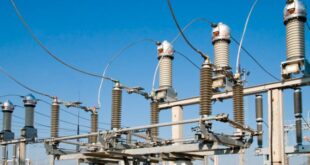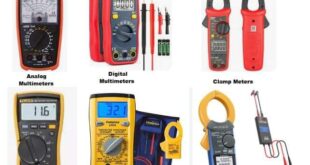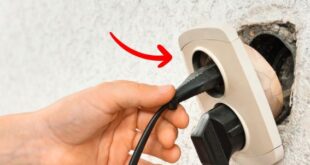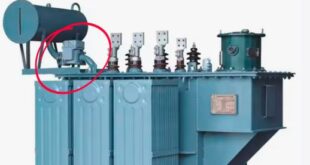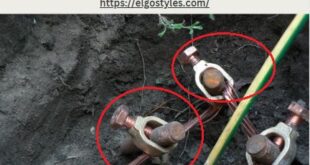Lightning: AC or DC? Lightning: AC or DC?—The Full Explanation When lightning strikes, it releases an astonishing amount of electrical energy in an instant. From a scientific and engineering perspective, understanding the nature of this energy can help us design better protection systems, from surge protectors to lightning rods. The …
Read More »Why Do My Outlets Spark When I Plug Something In?
Why Do My Outlets Spark When I Plug Something In? It happens in a flash. You plug in your phone charger or your hair dryer, and suddenly, a little spark appears from the outlet. It might make you pause and wonder: Is this normal, or is something wrong? Here’s everything …
Read More »Why Don’t Birds Get Electrocuted on Power Lines?
Why Don’t Birds Get Electrocuted on Power Lines? Birds on power lines are a common sight. As you watch them sitting high above the ground, seemingly without a care in the world, you may wonder—why don’t they get electrocuted? After all, those power lines carry thousands of volts of electricity. …
Read More »MultiVolt™ Cordless Rebar Bender/Cutter Review
Metabo HPT 36V MultiVolt™ Cordless Rebar Bender/Cutter Review for Electrical Field The Metabo HPT 36V MultiVolt™ Cordless Rebar Bender/Cutter (VB3616DA) is an essential tool for professionals working in the electrical field, especially for projects requiring reinforced concrete structures to support heavy-duty electrical equipment. This industry-first cordless bender and cutter delivers …
Read More »Can a Power Surge Destroy Your Devices?
Can a Power Surge Destroy Your Devices? Everything You Need to Know Have you ever experienced flickering lights during a storm or watched in horror as your electronics suddenly shut down? That sudden loss of power may be the result of a power surge, and if you’re not careful, it …
Read More »YouTubers Build the World’s Largest iPhone—And It Actually Works!
YouTubers Break Guinness World Record with Fully Functional Giant iPhone In an unprecedented feat of engineering, popular tech YouTubers Arun Maini, known as Mrwhosetheboss, and Matthew Perks, the mind behind DIYPerks, have officially constructed the world’s largest iPhone 15 Pro Max, standing at an astounding 6.74 feet tall. This creation, …
Read More »Electrocuted Birds Falling from Power Lines Are Igniting Wildfires Across the U.S
Electrocuted Birds Falling from Power Lines Are Igniting Wildfires Across the U.S. In a surprising and alarming phenomenon, electrocuted birds are causing wildfires across the United States, with a recent report identifying them as a contributing factor in at least 44 wildfires between 2014 and 2018. These avian-related fires have …
Read More »China’s Shenlong Space Plane Lands After 268 Days, Marking Major Milestone
China’s Shenlong Space Plane Lands After 268 Days, Marking Major Milestone China’s secretive space plane, Shenlong, has returned to Earth safely after 268 days in orbit, marking its third successful mission. The reusable experimental spacecraft landed in the Gobi Desert on September 5, 2024. Its mission, launched aboard a Long …
Read More »Neuralink’s First Patient Names His Brain Implant ‘Eve’ and Uses It to Learn French and Japanese
Neuralink’s First Patient Names His Brain Implant ‘Eve’ and Uses It to Learn French and Japanese The Future of Mind-Controlled Technology Is Here!” Neuralink’s first patient, Noland Arbaugh, has taken a significant step forward in the evolving world of brain-implant technology. Seven months after receiving the brain chip, Arbaugh has …
Read More »Apple to Surpass Nvidia as Top AI Stock in 2025, Says Citi
Apple to Surpass Nvidia as Top AI Stock in 2025, Says Citi Apple is poised to overtake Nvidia as the leading AI stock by 2025, according to a new report from Citi. The bank predicts that the AI trade, which has been dominated by infrastructure such as chips and servers, …
Read More »Apple and Nvidia Eye Major Investments in OpenAI, Valuing AI Leader at $100 Billion
Apple and Nvidia Eye Major Investments in OpenAI, Valuing AI Leader at $100 Billion Apple and Nvidia are reportedly in discussions to become significant investors in OpenAI, the creator of ChatGPT, as part of a new fundraising round that could value the AI powerhouse at $100 billion. According to sources …
Read More »ChatGPT Maker OpenAI Nearing $100 Billion Valuation—Is This the Future of AI?
OpenAI in Talks for Funding Round Valuing It Above $100 Billion San Francisco-based artificial intelligence pioneer OpenAI is reportedly in discussions to raise several billion dollars in a new funding round that would catapult the company’s valuation above $100 billion. This marks a significant leap from its previous valuation of …
Read More »Microsoft to Buy Solar Power From Singapore Public Buildings
Microsoft to Buy Solar Power From Singapore Public Buildings Singapore – In a significant move towards achieving its ambitious climate goals, Microsoft has signed a 20-year agreement with EDP Renewables (EDPR) to purchase 100% of the solar energy generated from the SolarNova 8 project in Singapore. This landmark deal is …
Read More »Building Homes from Dirt? UN Deploys 3D Printer for building Homes
UNDP Deploys Innovative 3D Printing Technology to Address Housing Crisis in Colombia In a groundbreaking effort to combat Colombia’s severe housing deficit, the United Nations Development Program (UNDP) has acquired a revolutionary 3D printer from WASP (World’s Advanced Saving Project) to construct homes using locally sourced materials. This initiative marks …
Read More »Biocomputers’ Made of Human Brain Cells Now Available for Rent at $500/Month
Biocomputers’ Made of Human Brain Cells Now Available for Rent at $500/Month Priced at $500 per month, these organoids can last up to 100 days and are currently being used by select universities to advance AI research and explore new training methods. In a groundbreaking development, FinalSpark, a Swiss technology …
Read More »Atlanta Deploys Autonomous Robot to Combat Crime in Troubled Neighborhood
Autonomous Robot Patrols Atlanta’s Crime-Ridden Streets Amid Safety Concerns Atlanta’s Old Fourth Ward, particularly the Boulevard Street area, has recently become the focus of public safety concerns due to a significant increase in violent crimes over the past seven months. In response, an autonomous surveillance robot, developed by Knightscope, has …
Read More »Elon Musk’s Neuralink Hits Milestone with Successful Second Implant Trial for Paralyzed Patients
Elon Musk’s Neuralink Hits Milestone with Successful Second Implant Trial for Paralyzed Patients Elon Musk’s brain-computer interface company, Neuralink, has achieved a significant milestone with its second successful implant in a human participant. The latest patient, identified as Alex, has experienced positive results, with no signs of the thread retraction …
Read More »Astronauts Butch Wilmore and Sunita Williams are stuck in spaceX until February 2025
Astronauts Butch Wilmore and Sunita Williams are stuck in spaceX until February 2025 CAPE CANAVERAL, Fla. — In an unexpected turn of events, NASA astronauts Butch Wilmore and Sunita Williams are facing an extended stay on the International Space Station (ISS) after their return mission was postponed until February 2025. …
Read More »Google Introduces New AI Tool to Help YouTube Users Recover Hacked Accounts
Google Introduces New AI Tool to Help YouTube Users Recover Hacked Accounts In response to the increasing number of social media hacks, Google-owned YouTube has introduced a new artificial intelligence (AI) tool to help users recover their hacked accounts. The AI-powered chatbot, which is available through the YouTube Help Center, …
Read More »Your Smartwatch is Lying You About Your Health
Your Smartwatch is Lying You About Your Health Smartwatches have become a staple for many, offering a range of health-tracking features from heart rate monitoring to sleep analysis. However, a recent review study highlights the potential inaccuracies in the data provided by these devices, raising concerns about their reliability. “Smartwatches …
Read More »Smart Fabric: Generating Electricity from Body Heat
Researchers Develop Revolutionary Smart Fabric: Generating Electricity from Body Heat In a groundbreaking development, researchers at the University of Waterloo have unveiled a new type of fabric capable of generating electricity from body heat and sunlight, marking a significant leap forward in smart textile technology. This innovative fabric has the …
Read More »Robot with Human-Like Expressions Pretends to Be a Patient to train doctors
Meet RIA: Robot with Human-Like Expressions Pretends to Be a Patient to train doctors A new era of medical training has begun at the UC San Diego Division of Extended Studies, where an AI-powered humanoid robot named RIA is transforming the way doctors prepare for real-world patient care. Developed by …
Read More »South Korea Records First-Ever Robot ‘Suicide’
South Korea Records First-Ever Robot ‘Suicide’ as Overworked Droid Throws Itself Down Stairs In an unprecedented and tragic event, a robot employed by the Gumi City Council in South Korea is believed to have committed the first recorded instance of robot suicide. The robot, known as the “Robot Supervisor,” was …
Read More »Top 15 Essential Electrician Tools
Top 15 Essential Electrician Tools Whether you’re a seasoned electrician or just starting out, having the right tools is crucial for efficiency and safety. Here’s a comprehensive guide to the top 15 essential electrician tools, along with their pros and cons, to help you make informed purchases. As an Amazon …
Read More »What is the white smoke that trails behind an airplane’s wing tips when it is landing?
What is the white smoke that trails behind an airplane’s wing tips when it is landing? Answer: The white smoke trailing behind an airplane’s wing tips when it is landing is condensation of water vapor due to changes in air pressure. Reasoning: The white smoke seen trailing behind an airplane’s …
Read More »Wiha Slotted And Phillips Insulated Screwdriver Set Review
Wiha 32092 Slotted and Phillips Insulated Screwdriver Set, 1000 Volt Review The Wiha 32092 Slotted and Phillips Insulated Screwdriver Set is a robust and reliable choice for any professional electrician or DIY enthusiast. Here’s an in-depth review of this versatile toolset: Brand: Wiha Wiha is renowned for its high-quality tools, …
Read More »Do Solar Panels Increase the Temperature of the Earth?
Do Solar Panels Increase the Temperature of the Earth? Answer No, solar panels do not significantly increase the temperature of the Earth. Reasoning Solar panels convert sunlight into electricity, reducing the need for fossil fuels and thereby lowering greenhouse gas emissions. While they absorb sunlight, their surface does not significantly …
Read More »Electric Wall Groove Cutting Machine Review
TIEKJOT Electric Wall Groove Cutting Machine/ Chaser Concrete Cutter Brand: TIEKJOT Color: Red Blade Material: High-Speed Steel Surface Recommendation: Wall Power Source: Corded Electric Overview The TIEKJOT Electric Wall Groove Cutting Machine is a robust and efficient tool designed for professionals needing precise and clean cuts in concrete, brick, marble, …
Read More »Permanent-Magnet Synchronous Motors
Permanent-Magnet Synchronous Motors (PMSM) Introduction Permanent-Magnet Synchronous Motors (PMSMs) are a type of synchronous motor that uses permanent magnets embedded in the steel rotor to create a constant magnetic field. The stator, typically made of laminated steel with windings, produces a rotating magnetic field when powered by an alternating current …
Read More »Electrical Safety Regulations and Standards
Electrical Safety Regulations and Standards Introduction Electrical safety regulations and standards are an essential aspect of workplace safety, and adherence to these standards can prevent workplace accidents and injuries. In the United States, organizations such as OSHA and NFPA have established electrical safety regulations and standards that companies must follow …
Read More »Does ground mean zero voltage?
Answer: Yes, ground typically refers to a reference point with zero voltage. Reasoning: In electrical engineering, ground is often used as a reference point for voltage measurements. It’s conventionally assumed to have zero voltage because it’s connected to the Earth, which acts as a large reservoir of charge. By connecting …
Read More »12 Most Common Mistakes in Solar Installations
Mistakes to avoid when installing solar panels Harnessing solar energy through installations has become increasingly popular as the world shifts towards sustainable energy sources. However, despite its growing popularity, solar installations can still encounter numerous pitfalls, leading to inefficiencies, increased costs, or even safety hazards. Understanding and avoiding these common …
Read More »What happens to a Capacitor at high voltage?
What happens to a Capacitor at high voltage? Answer: At high voltage, a capacitor can experience dielectric breakdown, leading to insulation failure and potential damage to the capacitor. Reasoning: When a capacitor is exposed to high voltage, the electric field across the dielectric material increases. If the voltage exceeds the …
Read More »Does increasing the number of fan blades increase the output airflow?
Does increasing the number of fan blades increase the output airflow? Answer: Increasing the number of fan blades does not necessarily increase the output airflow. The airflow depends on various factors including blade design, pitch, motor power, and overall fan efficiency. Reasoning: While adding more blades might seem like …
Read More »Do solar panels use light or heat?
Do solar panels use light or heat? Answer: Solar panels use light, not heat, to generate electricity. Reasoning: Solar panels, specifically photovoltaic (PV) panels, convert sunlight (light energy) directly into electricity using the photovoltaic effect. When sunlight hits the semiconductor material in the solar cells, it excites electrons, creating an …
Read More »How can snakes accidentally cause a short circuit or the breakdown of power system?
How can snakes accidentally cause a short circuit or the breakdown of power system? Answer Snakes can cause short circuits or power system breakdowns by entering electrical substations or transformers and bridging conductive components, leading to electrical faults. Reasoning Snakes often seek warmth and shelter in electrical substations and transformers. …
Read More »Electrical Engineer | The Resolute Group Ltd | Electrical Jobs
Electrical Engineer | The Resolute Group Ltd | Electrical Jobs Company: The Resolute Group Ltd Job Title/ Position: Electrical Engineer Location: Düsseldorf, North Rhine-Westphalia, Germany Employment Type: On-site, Full-time Industry: Staffing and Recruiting Apply Now Job Description Overview: An excellent opportunity for a junior Electrical Engineer to be a key …
Read More »What will happen if I wire 100 car batteries wired in parallel?
What will happen if I wire 100 car batteries wired in parallel? Answer Wiring 100 car batteries in parallel increases the total current capacity but maintains the same voltage. This setup can produce very high current, but poses significant safety risks including overheating, short circuits, and potential explosions. Reasoning When …
Read More »What is difference between Contrails vs. Chemtrails?
Contrails vs. Chemtrails: Understanding the Differences The sky is often crisscrossed with white streaks left by high-flying aircraft. These trails, while familiar to many, have sparked both scientific explanations and conspiracy theories. The terms “contrails” and “chemtrails” refer to these phenomena, but they describe vastly different concepts. Here, we explore …
Read More »How Do Electric Lighters Work?
How Do Electric Lighters Work? Answer: Electric lighters work by using an electric arc or a heating element to ignite materials, instead of a traditional flame. When activated, electricity flows through electrodes, creating a high-voltage arc or heating a coil, which generates enough heat to ignite the target material. Reasoning: …
Read More »How do AI-based virtuals like Alexa and Siri work?
How do AI-based virtuals like Alexa and Siri work? Answer AI-based virtual assistants like Alexa and Siri work by using voice recognition, natural language processing (NLP), and machine learning to understand and respond to user commands. Reasoning AI-based virtual assistants such as Alexa and Siri function through a combination of …
Read More »How do inductive cooktops work?
How Do Inductive Cooktops Work? Answer Inductive cooktops work by using electromagnetic induction to heat cookware directly. When the cooktop is turned on, an electric current passes through a coil under the cooking surface, creating a magnetic field. This magnetic field induces an electric current in the ferrous (iron-containing) cookware, …
Read More »How do noise-cancelling headphones work?
How do noise-cancelling headphones work? Answer Noise-cancelling headphones use active noise control to reduce unwanted ambient sounds by producing sound waves that are the exact negative of the external noise, thereby canceling it out. Reasoning Noise-cancelling headphones work through a process called active noise control (ANC). They have built-in microphones …
Read More »How does a digital clock keep time?
Answer A digital clock keeps time using a quartz crystal oscillator, which generates precise frequency signals to accurately measure and display the passage of time. Reasoning Digital clocks keep time using an electronic oscillator regulated by a quartz crystal. Quartz crystals have piezoelectric properties, meaning they generate a consistent electrical …
Read More »How does a GPS device determine your location?
How does a GPS device determine your location? Answer: A GPS device determines your location by triangulating signals from multiple satellites in the Global Positioning System network. Reasoning A GPS device determines your location through a process called trilateration. Here’s a detailed explanation: Satellite Signals: The GPS device receives signals …
Read More »How does a wearable fitness tracker measure steps?
How does a wearable fitness tracker measure steps? Answer: A wearable fitness tracker measures steps using an accelerometer to detect motion and analyze patterns to identify steps. Reasoning: How does a wearable fitness tracker measure steps? A wearable fitness tracker typically uses a built-in accelerometer to measure steps. The accelerometer …
Read More »Why do batteries degrade over time?
Why do batteries degrade over time? Answer: Batteries degrade over time due to chemical reactions that reduce their ability to hold a charge, such as the formation of solid electrolyte interphase (SEI), loss of active material, and growth of dendrites. Complete reasoning: Batteries degrade over time because of several interconnected …
Read More »What is hybrid potentiometer?
Understanding Hybrid Potentiometers Introduction Potentiometers, commonly known as “pots,” are fundamental components in electronic circuits used to measure and adjust electrical resistance. Their primary role involves controlling voltage levels and current flow in various devices, from simple volume controls in audio equipment to complex industrial machinery. As technology advances, so …
Read More »Why do electronic devices heat up?
Answer: Electronic devices heat up due to electrical resistance in components, which converts electrical energy into heat, and because of the work performed by the device. Reasoning: Electronic devices heat up primarily because of electrical resistance in their components. When electrical current flows through a device, the resistance causes some …
Read More »Why do some electronic devices need grounding?
Why do some electronic devices need grounding? Answer: Grounding electronic devices provides a safe path for excess electrical current to disperse into the earth, protecting users from electric shock and preventing damage to the device. Reasoning: Some electronic devices need grounding to ensure safety and proper functioning. Grounding provides a …
Read More »Why Most Airplanes Are Painted White?
Why Most Airplanes Are Painted White? Answer: Most airplanes are painted white because white paint reflects sunlight, reducing heat absorption and helping maintain a cooler temperature. It also shows cracks, dents, and other damages more clearly, ensuring better safety and maintenance. Complete Reasoning: Thermal Efficiency: White paint reflects most of …
Read More »Why Some Phone Chargers Are Faster Than Others?
Why Some Phone Chargers Are Faster Than Others? Answer Some phone chargers are faster than others due to differences in power output, charging technology, and device compatibility. Reasoning Power Output: Chargers with higher wattage (measured in watts, W) deliver more power to the device, resulting in faster charging. For example, …
Read More »How do wireless chargers work?
How do wireless chargers work? Answer Wireless chargers work by using electromagnetic induction to transfer energy from the charger to a compatible device without the need for physical connectors. Reasoning Wireless chargers operate through a process called electromagnetic induction. Inside the charger, there is a coil that generates an alternating …
Read More »What happens when you’re on a plane and don’t put your phone on airplane mode?
What happens when you’re on a plane and don’t put your phone on airplane mode? Answer When you don’t put your phone on airplane mode while on a plane, it can cause interference with the aircraft’s communication and navigation systems, potentially affecting flight safety. Reasoning When a phone is not …
Read More »Why do planes have white smoke?
Why do planes have white smoke? Answer Planes have white smoke, called contrails, because of the condensation of water vapor in the exhaust of jet engines when it mixes with cold air at high altitudes. Reasoning The white smoke seen trailing behind planes is known as contrails, short for condensation …
Read More »Why does AC not go below 16 degrees?
Why cant the A/C go lower than 16C° if it can keep cooling the room? Answer An air conditioner cannot go lower than 16°C due to design limitations, energy efficiency, and the risk of freezing the internal components. Complete Reasoning Air conditioners have a lower limit on the temperature they …
Read More »Kit de práctica de soldadura
Kit de práctica de soldadura para principiantes Kit de práctica de soldadura para principiantes El Kit de práctica de soldadura es la herramienta perfecta para aquellos que están dando sus primeros pasos en el mundo de la soldadura. Con 24 cupones de soldadura premium de PCS, este kit ofrece una …
Read More »Soldadura con electrodo revestido y TIG
Soldadura con electrodo revestido y TIG Introducción Breve explicación de la soldadura con electrodo revestido y TIG La soldadura con electrodo revestido y la soldadura TIG (Tungsten Inert Gas) son dos técnicas fundamentales en el campo de la soldadura. Ambos procesos implican la fusión de metales para crear uniones fuertes …
Read More »Soldadura Subacuática
Soldadura Subacuática Introducción: La soldadura subacuática, o “soldadura subacuática”, se refiere al proceso de unir materiales bajo el agua, generalmente metales, utilizando diversas técnicas de soldadura. Esta forma especializada de soldadura tiene una gran importancia en industrias como la construcción offshore, la construcción naval, el mantenimiento submarino y la reparación. …
Read More »Tipos de juntas de soldadura
Introducción: La soldadura es un proceso fundamental en la fabricación y construcción, que une materiales para crear estructuras y componentes de todos los tamaños y complejidades. En el corazón del arte y la ciencia de la soldadura se encuentran las uniones soldadas, que definen cómo se fusionan dos o más …
Read More »Soldadura Laser
Soldadura Laser Introducción: La soldadura es un arte milenario que ha evolucionado con el tiempo, adoptando nuevas tecnologías para mejorar su eficiencia y precisión. Una de estas innovaciones es la soldadura láser, una técnica avanzada que ha revolucionado la industria de la fabricación. En este artículo, exploraremos en profundidad la …
Read More »Casco de Soldadura
Mejores Cascos de Soldadura Cuando se trata de soldadura, la seguridad siempre debe ser una prioridad. Y en el corazón de la seguridad en la soldadura se encuentra un casco de soldadura de calidad. Estas piezas esenciales no solo protegen los ojos y la cara del soldador de la luz …
Read More »Soldadura Con Termita
Soldadura Con Termita Introducción: La soldadura con termita es un proceso único y poderoso en el mundo de la metalurgia. A menudo pasado por alto en comparación con otros métodos de soldadura más comunes, la soldadura con termita merece una atención especial por sus aplicaciones específicas y su eficacia en …
Read More »Soldadura Tig Aluminio
Soldadura Tig Aluminio 1- Introducción: La soldadura TIG en aluminio, conocida como “Soldadura Tungsteno Inerte Gas”, es una técnica altamente especializada y demandada en diversas industrias. Su aplicación requiere habilidad, conocimiento y equipo adecuado. En este artículo, exploraremos en profundidad todo lo relacionado con la soldadura TIG en aluminio, desde …
Read More »Soldadura TIG
Soldadura TIG Introducción: La soldadura TIG, o Tungsten Inert Gas, es una de las técnicas de soldadura más versátiles y ampliamente utilizadas en la industria. Con su capacidad para soldar una amplia gama de metales y producir soldaduras limpias y de alta calidad, la soldadura TIG es imprescindible para cualquier …
Read More »Soldadura Por Puntos
Soldadura Por Puntos Introducción: La soldadura por puntos es una técnica ampliamente utilizada en la industria metalúrgica, especialmente en la fabricación de automóviles, electrodomésticos y otros productos metálicos. En este artículo, exploraremos en profundidad qué es la soldadura por puntos, cómo funciona, sus aplicaciones, ventajas y desventajas, así como algunos …
Read More »Soldadura En Frio
¿Qué es la Soldadura en Frío? Introducción La soldadura es un proceso fundamental en la industria metalúrgica que implica la unión de materiales metálicos mediante la fusión. Sin embargo, existe una técnica menos conocida pero igualmente importante: la soldadura en frío. En este artículo, exploraremos en profundidad qué es la …
Read More »Máquina de Soldadura ARC Portátil de 110V de Faiuot
Revisión de la máquina de soldadura por arco portátil Faiuot de 110 V: Un Análisis Detallado Introducción: La Máquina de Soldadura ARC Portátil de 110V de Faiuot es un aparato de soldadura compacto y versátil diseñado para satisfacer las necesidades tanto de principiantes como de soldadores experimentados. En esta revisión …
Read More »Soldadura por Arco de Metal con Núcleo Fundente (FCAW)
Introducción La soldadura por arco de metal con núcleo fundente (FCAW, por sus siglas en inglés) es un proceso de soldadura ampliamente utilizado en diversas industrias debido a su versatilidad y eficiencia. En este artículo, exploraremos en detalle qué es la soldadura FCAW, cómo funciona, sus aplicaciones, ventajas y desventajas, …
Read More »Soldadura por arco y sus tipos
Soldadura por arco y sus tipos Introducción: La soldadura por arco es un proceso esencial en la industria metalúrgica, ofreciendo una amplia gama de aplicaciones y técnicas. En este artículo, exploraremos detalladamente la soldadura por arco y sus diversos tipos, proporcionando una comprensión completa de este método de unión de …
Read More »Tipos De Técnicas De Soldadura
Tipos De Técnicas De Soldadura Las técnicas de soldadura son fundamentales en la unión de metales y la fabricación de una amplia gama de productos. Desde el clásico arco eléctrico hasta las innovadoras tecnologías láser, cada método ofrece ventajas únicas que se adaptan a diferentes necesidades industriales. Exploraremos aquí algunos …
Read More »Soldadura TIG con Gas de Tungsteno Inerte
Soldadura TIG con Gas de Tungsteno Inerte Introducción La soldadura TIG, también conocida como soldadura de arco con gas de tungsteno (GTAW por sus siglas en inglés), es un tipo de proceso de soldadura que une dos piezas de metal utilizando un electrodo de tungsteno no consumible. Se suministra un …
Read More »¿Qué es soldar? Definición y tipos de soldadura
¿Qué es soldar? Definición y tipos de soldadura La soldadura es un proceso esencial en la fabricación, la construcción y la reparación de una amplia variedad de estructuras y componentes metálicos. Consiste en la unión permanente de dos o más piezas de metal mediante la aplicación de calor o presión, …
Read More »Soldadura MIG/MAG
Soldadura MIG/MAG Introducción La soldadura figura como una de las técnicas más cruciales en diversas industrias, contribuyendo significativamente a los sectores de fabricación y construcción. Entre los diversos métodos de soldadura, la soldadura MIG/MAG emerge como un proceso versátil y ampliamente utilizado debido a su eficiencia, velocidad y calidad. Esta …
Read More »Why do incandescent lamps blink when connected to AC power?
Answer: Incandescent lamps blink when connected to AC power due to the alternating current causing the filament to heat and cool rapidly, leading to visible flickering. Reasoning: Incandescent lamps contain a filament that emits light when heated by an electric current. When connected to AC power, the current alternates direction …
Read More »Why Your Circuit Breaker Keeps Tripping?
Why Your Circuit Breaker Keeps Tripping? Introduction: As an electrical support engineer, one of the most common issues you’ll encounter in residential and commercial settings is circuit breaker tripping. It’s a recurring frustration for many homeowners and business owners alike. Understanding why your circuit breaker keeps tripping is essential for …
Read More »How To Tell If A Circuit Breaker Is Bad?
How To Tell If A Circuit Breaker Is Bad? Introduction: In any electrical system, circuit breakers serve as crucial guardians, protecting circuits from overloads and potential hazards. However, like any component, they can degrade over time, potentially leading to malfunction. As electrical support engineers, it’s essential to discern the signs …
Read More »Can you still use dimmer switches when installing LED bulbs?
Answer: Yes, you can use dimmer switches with LED bulbs, but it’s crucial to ensure compatibility for optimal performance. Reasoning: Using dimmer switches with LED bulbs is feasible, but compatibility is essential. Traditional dimmer switches may not be suitable for LEDs due to differences in technology. LED bulbs require dimmers …
Read More »Why is Megger used instead of a multimeter for insulation testing?
Answer: Megger is preferred over a multimeter for insulation testing because it applies a higher voltage, typically 500V or more, which is necessary to accurately assess the insulation resistance and detect potential faults. Reasoning: Insulation testing requires the application of a higher voltage to accurately measure the resistance of insulation …
Read More »What happens if you touch a negative side to a battery of positive side?
Answer: Touching the negative and positive sides of a battery together creates a short circuit, allowing a large current to flow between them. This can lead to rapid discharge of the battery, generation of heat, and potential damage to the battery or surrounding objects. Reasoning: Short Circuit: When the negative …
Read More »What Happens If I Touch Both Terminals Of A 12V Battery?
Answer: If you touch both terminals of a 12V battery, you create a closed circuit, allowing current to flow through your body, potentially causing electric shock, burns, or even death. Reasoning: When you touch both terminals of a 12V battery, you complete the circuit, allowing electricity to flow through your …
Read More »Is it safe to sit inside a car during a lightning strike?
Answer: Yes, sitting inside a car during a lightning strike is generally safe due to the Faraday cage effect, where the metal frame of the car conducts electricity around the occupants, keeping them safe from harm. Reasoning: Cars are designed with metal frames that act as Faraday cages, diverting lightning’s …
Read More »Does pure water conduct electricity? If not, what can we do to make it conducting?
Answer: Pure water does not conduct electricity because it lacks ions necessary for the flow of electrical current. To make it conducting, we can add impurities or electrolytes like salt. Reasoning: Pure water, consisting only of H2O molecules, lacks ions necessary for the conduction of electricity. In its purest form, …
Read More »Potentiometer Circuit Diagram and Working
Potentiometer Circuit Diagram and Working Introduction Potentiometers, also known as variable resistors, are a fundamental component in electronic circuits. They are used to control the flow of electrical current in a circuit by altering the resistance of the circuit. Potentiometers are widely used in various applications, such as volume controls …
Read More »What is the difference between MCB, MCCB, ELCB and RCCB?
Differences Between MCB, MCCB, ELCB, and RCCB Introduction: In the realm of electrical engineering and circuit protection, the acronyms MCB, MCCB, ELCB, and RCCB often arise. Understanding the distinctions between these devices is crucial for ensuring the safety and efficiency of electrical systems. In this article, we’ll delve into the …
Read More »Efficient Voltage Control Strategies for Modern Power Systems
Efficient Voltage Control Strategies for Modern Power Systems Introduction Voltage control is a crucial aspect of power system operation and stability. In a power system, maintaining the voltage within a specified range is essential for ensuring efficient power delivery and preventing damage to equipment. Voltage control becomes even more critical …
Read More »Oscilloscope Guide
Oscilloscope Guide Introduction Definition and purpose of an oscilloscope An oscilloscope, often referred to as an “scope” or “o-scope,” is an electronic test instrument used to visualize and analyze electrical waveforms. It displays voltage signals in the time domain, allowing engineers and technicians to observe the characteristics of various electronic …
Read More »Electrical Power – Its Types and Units
Electrical Power – Its Types and Units Introduction Electrical power is a fundamental concept that plays a pivotal role in modern society. From lighting our homes to powering vast industries, electrical power has become an indispensable part of our daily lives. In this article, we will explore what electrical power …
Read More »Electrical Distribution Substation
Electrical Distribution Substation: The Nerve Center of Power Delivery In the intricate web of electrical infrastructure, distribution substations play a pivotal role, serving as the critical juncture where high-voltage electricity is transformed and distributed to end-users at manageable voltages. These often inconspicuous yet indispensable facilities are the backbone of modern …
Read More »Multimeter Types and Their Applications
Multimeter Types and Their Applications Introduction Multimeters are indispensable tools used in various fields that involve electrical measurements. They play a vital role in diagnosing electrical problems, troubleshooting circuits, and ensuring accurate measurements of voltage, current, resistance, and other electrical parameters. Understanding the different types of multimeters and their applications …
Read More »Why some countries use 110V and others use 220V sockets?
Answer: The difference in voltage (110V vs. 220V) across countries is primarily due to historical, economic, and technical factors. Reasoning: The choice between 110V and 220V systems largely depends on historical development, economic considerations, and technical requirements. Countries like the United States and Japan typically use 110V due to early …
Read More »Why we use 400Hz Power Supply in Aircraft?
Answer: We use 400Hz power supply in aircraft for lighter, more efficient electrical systems, enabling smaller transformers and lighter cables. Reasoning: 400Hz power supply is utilized in aircraft due to several factors: Weight reduction: Higher frequency allows for smaller transformers and lighter cables, crucial for aircraft weight management. Efficiency: Electrical …
Read More »Can solar panels electrocute you?
Answer: No, properly installed and maintained solar panels do not pose a direct electrocution risk to individuals. Reasoning: Solar panels generate electricity from sunlight through photovoltaic cells. The direct current (DC) produced by solar panels is typically low voltage, which is generally not enough to cause electrocution. However, improper installation, …
Read More »Does a Ceiling Fan running at a slower speed consume less Power (Electricity Units)?
Answer: Yes, a ceiling fan running at a slower speed consumes less power (electricity units). Reasoning: Ceiling fans consume power based on their speed settings. Slower speeds require less energy to maintain, resulting in lower power consumption. This is because the fan’s motor operates at a reduced rate, resulting in …
Read More »What would happen if you wore anything metallic during an MRI?
Answer: Wearing anything metallic during an MRI can pose serious risks including tissue damage, burns, and even death due to the powerful magnetic fields of the MRI machine attracting metal objects. Reasoning: MRI machines use powerful magnets to generate images of the body’s internal structures. Metallic objects can become projectiles, …
Read More »Why are we not allowed to use umbrellas during substation visits?
Answer: Umbrellas are not allowed during substation visits due to the risk of electrical conductivity, which can lead to serious injury or even death. Reasoning: Umbrellas, typically made of metal or partially composed of metal, pose a significant risk in substations where there are high-voltage electrical equipment and conductors. The …
Read More »Is the Power of Zero Watt Bulb really zero watts?
Answer: No, the power of a “zero-watt” bulb is not literally zero watts. Instead, it refers to a very low power consumption. These bulbs typically consume minimal energy, often less than a watt, hence the term “zero-watt.” However, they still have a small power rating, typically ranging from 0.5 to …
Read More »What is Buchholz relay? Which equipment is protected by it?
Answer: A Buchholz relay is a safety device used in oil-filled power transformers and reactors to detect faults such as gas accumulation, oil leakage, or overheating. It protects these equipment by triggering alarms or disconnecting them from the power supply in case of a fault. Reasoning: A Buchholz relay is …
Read More »Why are outlets and receptacles in hospitals upside down?
Answer: Outlets and receptacles in hospitals are often installed upside down for safety reasons. Reasoning: In hospitals, upside-down outlets are a safety measure to prevent accidental disconnection of medical equipment. Placing the ground pin on top reduces the risk of objects falling into the sockets and causing a short circuit. …
Read More »Why is the Grounding Wire Bare and Not Insulated?
Answer: The grounding wire is bare and not insulated to ensure effective dissipation of electrical charges into the ground, preventing electrical hazards. Reasoning: The grounding wire serves as a safety measure in electrical systems. It’s designed to provide a path of least resistance for electrical current to flow into the …
Read More » Electrical Engineering World Wiring a Brighter Tomorrow!
Electrical Engineering World Wiring a Brighter Tomorrow!



